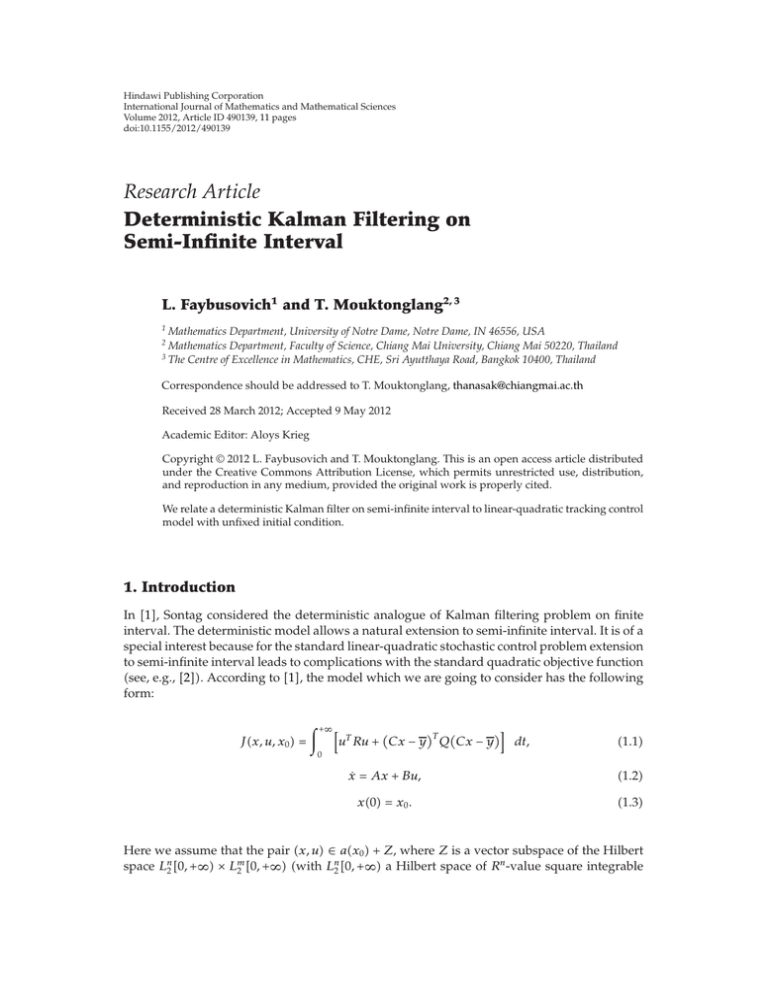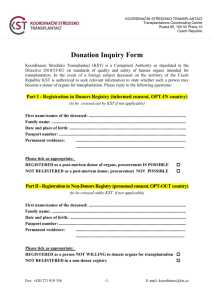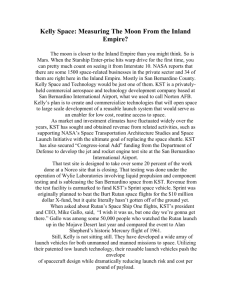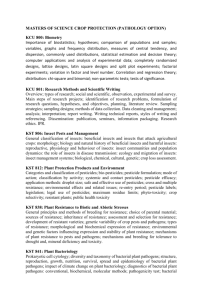Document 10455050
advertisement

Hindawi Publishing Corporation
International Journal of Mathematics and Mathematical Sciences
Volume 2012, Article ID 490139, 11 pages
doi:10.1155/2012/490139
Research Article
Deterministic Kalman Filtering on
Semi-Infinite Interval
L. Faybusovich1 and T. Mouktonglang2, 3
1
Mathematics Department, University of Notre Dame, Notre Dame, IN 46556, USA
Mathematics Department, Faculty of Science, Chiang Mai University, Chiang Mai 50220, Thailand
3
The Centre of Excellence in Mathematics, CHE, Sri Ayutthaya Road, Bangkok 10400, Thailand
2
Correspondence should be addressed to T. Mouktonglang, thanasak@chiangmai.ac.th
Received 28 March 2012; Accepted 9 May 2012
Academic Editor: Aloys Krieg
Copyright q 2012 L. Faybusovich and T. Mouktonglang. This is an open access article distributed
under the Creative Commons Attribution License, which permits unrestricted use, distribution,
and reproduction in any medium, provided the original work is properly cited.
We relate a deterministic Kalman filter on semi-infinite interval to linear-quadratic tracking control
model with unfixed initial condition.
1. Introduction
In 1, Sontag considered the deterministic analogue of Kalman filtering problem on finite
interval. The deterministic model allows a natural extension to semi-infinite interval. It is of a
special interest because for the standard linear-quadratic stochastic control problem extension
to semi-infinite interval leads to complications with the standard quadratic objective function
see, e.g., 2. According to 1, the model which we are going to consider has the following
form:
Jx, u, x0 ∞ T dt,
uT Ru Cx − y Q Cx − y
1.1
0
ẋ Ax Bu,
1.2
x0 x0 .
1.3
Here we assume that the pair x, u ∈ ax0 Z, where Z is a vector subspace of the Hilbert
n
n
space Ln2 0, ∞ × Lm
2 0, ∞ with L2 0, ∞ a Hilbert space of R -value square integrable
2
International Journal of Mathematics and Mathematical Sciences
functions is defined as follows:
Z x, u ∈ Ln2 0, ∞ × Lm
2 0, ∞ : x is absolutely continuous,
ẋ ∈ Ln2 0, ∞, ẋ Ax Bu, x0 0 .
1.4
Here A is an n by n matrix; B is an n by m matrix; R RT is an n by n and positive definite; Q QT is an r by r and positive definite; C is an r by n matrix; y ∈ Lr2 0, ∞. Notice that in 1.1–
n
1.3 x0 is not fixed and we minimize over all triple x, u, x0 ∈ Ln2 0, ∞ × Lm
2 0, ∞ × R
satisfying our assumption.
Notice also that we interpret 1.1–1.3 as an estimation problem of the form
ẋ Ax Bu,
y Cx v,
1.5
where we try to estimate x with the help of observation y by minimizing perturbations u,
v and choosing an appropriate initial condition x0 .
2. Solution of the Deterministic Problem
Consider the algebraic Riccati equation
KA AT K KLK − CT QC 0,
2.1
where L BR−1 BT . Assuming that the pair A, B is stabilizable and the pair C, A is detectable, there exists a negative definite symmetric solution Kst to 2.1 such that the matrix
A LKst is stable see, e.g., Theorem 12.3 in 3. According to 4, we have described a complete solution of the linear-quadratic control problem on a semi-infinite interval with the
linear term in the objective function. The major motivation for this extension comes from 5
where we consider applications of primal-dual interior-point algorithms to the computational
analysis of multicriteria linear-quadratic control problems in mini-max form. To compute a
primal-dual direction it is required to solve linear-quadratic control problems with the same
quadratic and different linear parts on each iteration. Using the results in 5, we can describe
the optimal solution to 1.1–1.3 with fixed x0 as follows.
There exists a unique solution ρ0 ∈ Ln2 0, ∞ satisfying the differential equation
ρ̇ −A LKst T ρ − CT Qy.
2.2
Moreover, ρ0 can be explicitly described as follows:
ρ0 t ∞
0
exp A LKst T τ CT Qyt τ dτ.
2.3
International Journal of Mathematics and Mathematical Sciences
3
The optimal solution x, u to 1.1–1.3 has the form
ẋ A LKst x Lρ0 , x0 x0 ,
u R−1 BT Kst x ρ0 .
2.4
2.5
For details see 5.
Notice that ρ0 does not depend on x0 . To solve the original problem 1.1–1.3 we need
to express the minimal value of the functional 1.1 in term of x0 .
Theorem 2.1. Let x, u be an optimal solution of 1.1–1.3 with fixed x0 given by 2.2–2.5.
Then
Jx, u, x0 & −
x0T Kst x0
∞ − 2ρ0 0 x0 y T Qy − ρ0T Lρ0 dt.
T
2.6
0
Remark 2.2. Notice that Jx, u, x0 is a strictly convex function of x0 and hence minimum of J
as a function of x0 is attained at
opt
x0
−1
−Kst
ρ0 0.
2.7
Hence 2.2–2.5 gives a complete solution of the original problem 1.1–1.3.
Proof. Let y, w ∈ ax0 Z be feasible solution to 1.1–1.3, where x0 is fixed. Consider
T
Δ y, w w − R−1 BT Kst y ρ0
· R · w − R−1 BT Kst y ρ0 ,
2.8
where we suppressed an explicit dependence on time. Notice that by 2.5
Δx, u ≡ 0,
Δ y, w ≡ 0,
2.9
for any feasible solution y, w implies that y, w x, u. Furthermore, let Δy, w Δ1 Δ2 Δ3 , where
Δ1 wT Rw,
T
Δ2 −2 Kst y ρ0 Bw,
Δ3 Kst y ρ0
T L Kst y ρ0 .
2.10
4
International Journal of Mathematics and Mathematical Sciences
Now Bw ẏ − Ay, and consequently
Δ2 −2 yT Kst ρ0T ẏ − Ay yT Kst A AT Kst y − 2yT Kst ẏ − 2ρ0T ẏ 2ρT Ay,
2.11
Δ3 yT Kst LKst y ρ0T Lρ0 2ρ0T LKst y.
Consequently,
d T
d T Δ y, w wT Rw ρ0T Lρ0 yT Kst LKst Kst A AT Kst y −
y Kst y − 2
ρ y
dt
dt 0
2ρ0T˙ y 2ρ0T LKst y 2ρ0T Ay.
2.12
Using 2.1 and 2.2, we obtain
T
d T d T
Δ y, w wT Rw ρ0T Lρ0 yT CT QCy − 2
ρ0 y −
y Kst y − 2 CT Qy y
dt
dt
T d T
d
ρ y −
yT Kst y y − Cy Q y − Cy − yT Qy.
wT Rw ρ0T Lρ0 − 2
dt 0
dt
2.13
Hence, taking into account that ρ0 t → 0, yt → 0, t → ∞ see, for details 5, we
obtain
∞
0
Δ y, w dt ∞ T wT Rw y − Cy Q y − Cy dt
0
∞ ρ0T Lρ0 − y T Qy dt 2ρ0 0T x0 x0 Kst x0
2.14
0
J y, w, x0 2ρ0 0T x0 x0 Kst x0 c,
∞
where c 0 ρ0T Lρ0 − yT Qy dt.
Notice, that Δy, w ≥ 0 and Δx, u ≡ 0. This shows that, indeed, x, u is an optimal
solution to 1.1–1.3 with fixed x0 and proves 2.6.
Remark 2.3. By 2.14 and Δx, u ≡ 0, we have Jy, w, x0 ≥ Jx, u, x0 and the equality
occurs if and only if y, w ≡ x, u see also 2.9. Hence x, u is a unique solution to the
problem 1.1–1.3. Similary reasoning works in discrete time case.
International Journal of Mathematics and Mathematical Sciences
5
3. Steady-State Deterministic Kalman Filtering
In light of 2.7, it is natural to consider the process
−1
ρ0 t,
zt −Kst
t ∈ 0, ∞
3.1
as a natural estimate for the optimal solution to problem 1.1–1.3. Let us find the differential equation for z.
Proposition 3.1. One has
−1 T
ż Az Kst
C Q y − Cz .
3.2
−1
is a solution to the algebraic equation
Remark 3.2. Notice that Kst
L − P CT QCP AP P AT 0.
3.3
In other words, the differential equation 3.2 is a precise deterministic analogue for the
stochastic differential equation describing the optimal steady-state estimation in Kalman
filtering problem. See, for example, 2.
Proof. Using 2.2 and 3.1, we obtain
−1
−1 T
C Qy
ż Kst
A LKst T ρ0 Kst
−1 T
−1 T
− Kst
A L Kst z Kst
C Qy.
3.4
Since Kst is a solution to 2.1, we have
−1 T
−1 T
A Kst − LKst A − Kst
C QC.
−Kst
3.5
−1 T
−1 T
C QCz Kst
C Qy.
ż Az − Kst
3.6
Hence,
Hence, we obtain 3.2.
Remark 3.3. Notice that due to 3.1 Δz, 0 ≡ 0 and consequently z, 0 would be an optimal
solution to 1.1–1.3 if it were feasible for this problem.
6
International Journal of Mathematics and Mathematical Sciences
4. The Solution of the Discrete Deterministic Problem
It is natural to consider the discrete version for the problem 1.1–1.3. In this case, the problem can be reformulated as follows:
Jx, u, x0 ∞ T 1
uTk Ruk Cxk − yk Q Cxk − y k −→ min,
2 k1
4.1
xk1 Axk Buk ,
4.2
x0 xo .
4.3
Here we let x denote a sequence {xk } ⊂ Rn for k 0, . . . , ∞. We say that x ∈ l2n N
if i1 xi 2 < ∞, where · is a norm induced by an inner product , in Rn . Let x, u ∈
l2n N × l2m N.
Like in the continuous case, we assume that the pair x, u ∈ ax0 Z, where Z is a
vector subspace of the Hilbert space l2n N × l2m N.
Observe now the inner product in H has the following form:
∞
∞
x, y , u, v H xk , uk yk , vk .
4.4
k0
The vector subspace Z now takes the following form:
Z {x, u ∈ H : xk1 Axk Buk , k 0, 1, . . . , x0 0}.
4.5
Here A is an n by n matrix. B is an n by m matrix. R RT is an n by n and positive definite.
Q QT is an r by r and positive definite. C is an r by n matrix and y ∈ l2r N.
As in the continuous case, we interpret 4.1–4.3 as an estimation problem of the
form
xk1 Axk Buk ,
y k Cxk vk ,
4.6
where we try to estimate x with the help of observation y by minimizing perturbations u,
v and choosing an appropriate initial condition x0 .
According to 4, a general cost function for a discrete linear-quadratic control problem
with linear term on the cost function has the following form:
Jx, u, x0 ∞ 1 T
xk Qxk uTk Ruk xkT ψk uTk φk −→ min,
2
k1
4.7
International Journal of Mathematics and Mathematical Sciences
7
where ψ ∈ l2n N and φ ∈ l2m N. The solution to the particular class of problems can be completely described by solving several system of recurrence relations and the following discrete
algebraic Riccati equation DARE:
−1 T
AT KB Q.
K AT KA − AT KB R BT KB
4.8
We assume that this equation has a positive definite stabilizing solution Kst . For sufficient
conditions, see 6.
In our situation, we have
Jx, u, x0 ∞ T 1
uTk Ruk Cxk − y k Q Cxk − yk −→ min .
2 k1
4.9
It is easy to see that ψk −CT Qyk and φk 0, k 0, 1, . . .. By 4, there is a unique solution
ρ {ρk } ∈ l2n N of the following recurrence relations
−1 T
T
T
ρk A − A Kst B R B Kst B BT ρk1 CT Qyk .
4.10
For details on an explicit solution of the above recurrence relation, see 4. For simplicity, we
let
R R BT Kst B ,
4.11
and we also let
−1
4.12
L BR BT .
So our recurrence relation for ρ now takes the form
ρk AT − AT Kst L ρk1 CT Qyk
4.13
with the corresponding DARE
−1 T
K AT KA − AT KB R AT KB CT QC,
K AT KA − AT KLKA CT QC.
4.14
The optimal solution to 4.1–4.3 has the following form:
T
xk1 AT − AT Kst L xk Lρk1 ,
−1
−1
uk −R BT Kst Axk R BT ρk1 .
4.15
4.16
8
International Journal of Mathematics and Mathematical Sciences
For details, see 4. To solve the original problem 4.1–4.3 we need to express the minimal
value of the functional 4.1 in terms of x0 .
Theorem 4.1. Let x, u be an optimal solution of 4.1–4.3 with fixed x0 given by 4.15-4.16.
Then
Jx, u, x0 ∞ 1
1 T
2y Tk Qy k − ρTk1 Lρk1 .
x0 Kst x0 − ρT0 x0 2
2 k0
4.17
Proof. For simplicity of notation, we use K for Kst . Let
T
−1
−1
Δ yk , wk wk R BT KAyk − ρk1
· R · wk R BT KAyk − ρk1
4.18
Δ1 Δ2 Δ3 ,
where
Δ1 wkT Rwk ,
T
Δ2 2 KAyk − ρk1 Bwk
T yk1 − Ayk
2 KAyk − ρk1
2ykT AT Kyk1 − 2ykT AT KAyk − 2ρTk1 yk1 2ρTk1 Ayk ,
4.19
T Δ3 KAyk − ρk1 L KAyk − ρk1
ykT AT KLKAyk ρTk1 Lρk1 − 2ykT AT KLρk1 .
We assume that y, w ∈ ax0 Z. Since AT KA − AT KLKA K − CT QC and AT −
AT KLρk1 ρk − CT Qyk , we have
Δ yk , wk wkT Rwk − 2ykT AT KA − AT KLKA yk − ykT AT KLKAyk
− 2ρTk1 yk1 2ρTk1 Ayk ρTk1 Lρk1 − 2ykT AT KLρk1 2ykT AT Kyk1
wkT Rwk − 2ykT K − CT QC yk − ykT AT KLKAyk − 2ρTk1 yk1
2ykT AT ρk1 ρTk1 Lρk1 − 2ykT AT KLρk1 2ykT AT Kyk1
wkT Rwk − 2ykT K − CT QC yk − ykT AT KLKAyk − 2ρTk1 yk1
2ykT AT − AT KL ρk1 ρTk1 Lρk1 2ykT AT Kyk1
International Journal of Mathematics and Mathematical Sciences
T
yk1
wkT Rwk − 2ykT K − CT QC yk − ykT AT KLKAyk − 2ρk1
9
2ykT ρk − CT Qy k ρTk1 Lρk1 2ykT AT Kyk1
wkT Rwk − 2ykT K − CT QC yk − ykT AT KLKAyk − 2ρTk1 yk1
2ykT ρk − 2ykT CT Qyk ρTk1 Lρk1 2ykT AT Kyk1 .
4.20
By recalling now the definition of R, we have
wkT Rwk wkT R BT KB wk
wkT Rwk wkT BT KBwk
wkT Rwk
T yk1 − Ayk K yk1 − Ayk
4.21
T
wkT Rwk yk1
Kyk1 ykT AT KAyk − 2ykT AT Kyk1 .
Therefore,
Δ yk , wk wkT Rwk − ykT Kyk − ykT CT QCyk − 2ρTk1 yk1 2ykT ρk
T
− 2ykT CT Qy k ρTk1 Lρk1 yk1
Kyk1 .
4.22
We then rearrange the terms and complete the square to obtain a useful expression for Δ:
T
Δ yk , wk wkT Rwk − ykT Kyk yk1
Kyk1 − 2ρTk1 yk1 2ρTk yk
ρTk1 Lρk1 ykT CT QCyk − 2ykT CT Qy k
T
wkT Rwk − ykT Kyk yk1
Kyk1 − 2ρTk1 yk1 2ρTk yk
4.23
T ρTk1 Lρk1 Cyk − yk Q Cyk − y k − 2y Tk Qy k .
Notice, since we fixed x0 , we let y0 x0 and take summation of both sides:
∞
∞ T wkT Rwk Cyk − y k Q Cyk − yk
Δ yk , wk − x0T Kx0 2ρT0 x0 k0
k0
∞ ρTk1 Lρk1
k0
−
2y Tk Qyk
.
4.24
10
International Journal of Mathematics and Mathematical Sciences
By the definition of Δyk , wk , Δxk , uk 0. Therefore,
0 −x0T Kx0 2ρT0 x0 2Jx, u, x0 ∞ ρTk1 Lρk1 − 2y Tk Qyk .
4.25
k0
As a result,
Jx, u, x0 ∞ 1
1 T
x0 Kx0 − ρT0 x0 2y Tk Qy k − ρTk1 Lρk1 .
2
2 k0
4.26
Then the proof is completed.
As in continuous case, for the discrete case, Jx, u, x0 is a strictly convex function of
x0 and hence minimum of J as a function of x0 is attained at
opt
x0
−1
Kst
ρ0 ,
4.27
where ρ is the unique l2 solution to 4.13.
Since we have 4.27, it is natural to consider the process
−1
ρk ,
zk Kst
4.28
as an estimate for the optimal solution to problem 4.1−4.3. Let us find the recurrence relation for zk .
Proposition 4.2. Assuming that the closed loop matrix A-LKA is invertible, one has
−1 −1
AT − AT Kst L
zk1 Azk − Kst
yk − Czk .
4.29
Proof. We can rewrite 4.13 in the form
Kst zk AT − AT Kst L Kst zk1 CT Qyk .
4.30
Using the algebraic Riccati equation
Kst AT Kst A − AT Kst LKst A CT QC,
4.31
we can rewrite 4.30 in the form
CT QCzk AT Kst − AT Kst LKst Azk AT − AT Kst L Kst zk1 CT Qyk ,
4.32
International Journal of Mathematics and Mathematical Sciences
11
which is equivalent to
AT − AT Kst L Kst zk1 AT − AT Kst L Kst Azk − CT Q yk − Czk .
4.33
The result follows.
Remark 4.3. Notice that 4.29 is the analogue of the “limiting” discrete Kalman filter 6, Page
384, 17.6.1.
5. Concluding Remarks
In this paper, we relate a deterministic Kalman filter on semi-infinite interval to linear-quadratic tracking control model with unfixed initial condition. Solutions of the deterministic problems both continuous and discrete cases are described. This extends the result of Sontag to
semi-infinite interval.
Acknowledgments
The research of L. Faybusovich was partially supported by National science foundation.
Grant DMS07-12809. The research of T. Mouktonglang was partially supported by the Centre of Excellence in Mathematics and the Commission for Higher Education CHE, Sri Ayutthaya Road, Bangkok, Thailand.
References
1
2
3
4
E. D. Sontag, Mathematical Control Theory, Springer, 1990.
M. H. A. Davis, Linear Estimation and Stochastic Control, Chapman and Hall, London, UK, 1977.
W. M. Wonham, Linear Multivariable Control, a Geometric Approach, Springer, 1974.
L. Faybusovich, T. Mouktonglang, and T. Tsuchiya, “Implementation of infinite-dimensional interiorpoint method for solving multi-criteria linear-quadratic control problem,” Optimization Methods & Software, vol. 21, no. 2, pp. 315–341, 2006.
5 L. Faybusovich and T. Mouktonglang, “Linear-quadratic control problem with a linear term on semiinfinite interval: theory and applications,” Tech. Rep., University of Notre Dame, 2003.
6 P. Lancaster and L. Rodman, Algebraic Riccati Equations, The Clarendon Press Oxford University Press,
Oxford, UK, 1995.
Advances in
Operations Research
Hindawi Publishing Corporation
http://www.hindawi.com
Volume 2014
Advances in
Decision Sciences
Hindawi Publishing Corporation
http://www.hindawi.com
Volume 2014
Mathematical Problems
in Engineering
Hindawi Publishing Corporation
http://www.hindawi.com
Volume 2014
Journal of
Algebra
Hindawi Publishing Corporation
http://www.hindawi.com
Probability and Statistics
Volume 2014
The Scientific
World Journal
Hindawi Publishing Corporation
http://www.hindawi.com
Hindawi Publishing Corporation
http://www.hindawi.com
Volume 2014
International Journal of
Differential Equations
Hindawi Publishing Corporation
http://www.hindawi.com
Volume 2014
Volume 2014
Submit your manuscripts at
http://www.hindawi.com
International Journal of
Advances in
Combinatorics
Hindawi Publishing Corporation
http://www.hindawi.com
Mathematical Physics
Hindawi Publishing Corporation
http://www.hindawi.com
Volume 2014
Journal of
Complex Analysis
Hindawi Publishing Corporation
http://www.hindawi.com
Volume 2014
International
Journal of
Mathematics and
Mathematical
Sciences
Journal of
Hindawi Publishing Corporation
http://www.hindawi.com
Stochastic Analysis
Abstract and
Applied Analysis
Hindawi Publishing Corporation
http://www.hindawi.com
Hindawi Publishing Corporation
http://www.hindawi.com
International Journal of
Mathematics
Volume 2014
Volume 2014
Discrete Dynamics in
Nature and Society
Volume 2014
Volume 2014
Journal of
Journal of
Discrete Mathematics
Journal of
Volume 2014
Hindawi Publishing Corporation
http://www.hindawi.com
Applied Mathematics
Journal of
Function Spaces
Hindawi Publishing Corporation
http://www.hindawi.com
Volume 2014
Hindawi Publishing Corporation
http://www.hindawi.com
Volume 2014
Hindawi Publishing Corporation
http://www.hindawi.com
Volume 2014
Optimization
Hindawi Publishing Corporation
http://www.hindawi.com
Volume 2014
Hindawi Publishing Corporation
http://www.hindawi.com
Volume 2014








